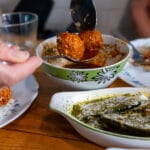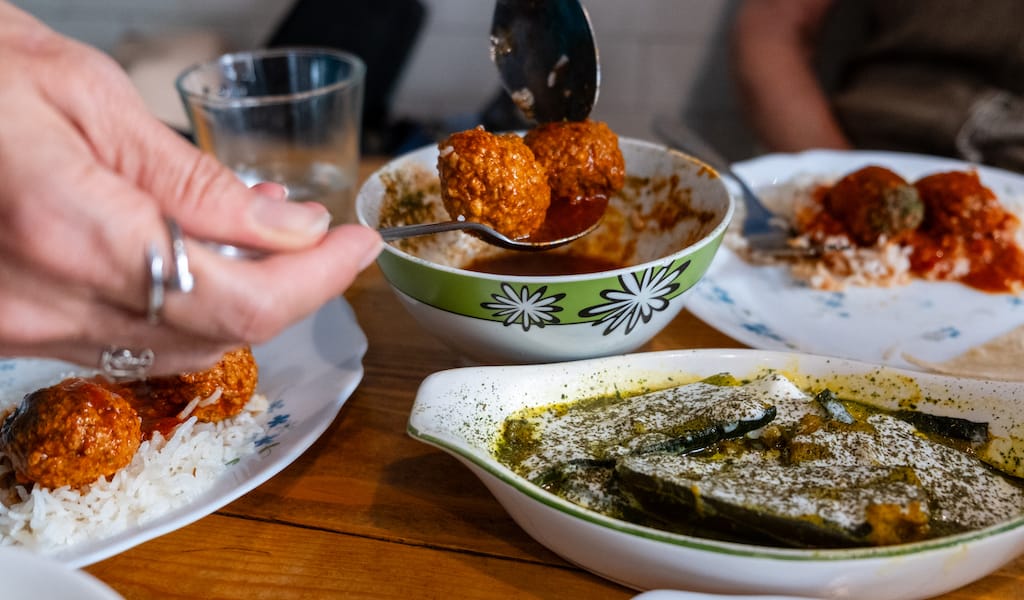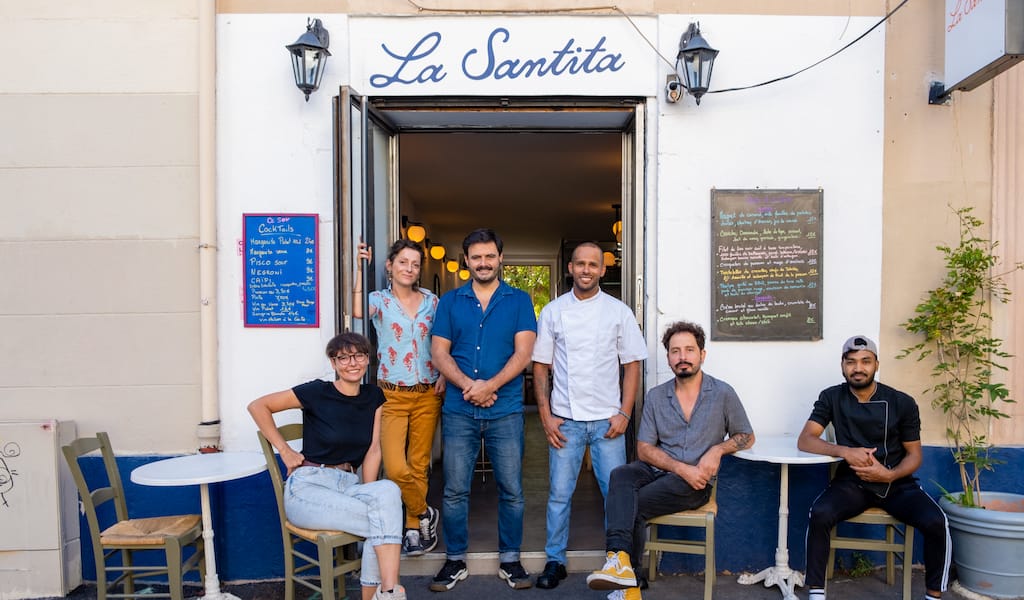Over many epochs, Marseille has experienced waves of immigration and is considered to be an invaluable gateway city to France. Italian immigration to Marseille began in the late 18th century and increased significantly after the end of World War I, when France’s industrial development required a great deal of labor. During the interwar period, 90 percent of the foreign population in Marseille was Italian.
Still today, 30 percent of the city’s population is of Italian origin. The current mayor of Marseille, Benoît Payan, is from a family with Italian roots. The similarities between Provençal and Italian dialects are evident.
There is no doubt that this cultural history has influenced the culinary tradition of the city. Pizza was first introduced to France in Marseille. All over the city, there are small Italian épiceries (specialty food shops) and restaurants. One spot in particular stands out among the others. On Rue Saint-Michel, a street revered by locals for the exceptional selection of boulangeries, fromageries, boucheries and traiteurs, we find Pâtes Fraiches et Raviolis, a small shop owned and run by Harut Harutyunyan. A family affair, he works along side his mother, Ruzanna and his sister, Ani.

Behind glass cases sit a variety of delicious homemade pastas, sauces, cheeses, and other Italian specialties, but the nonstop traffic to his shop is for a specific treat: Harut’s other-worldly homemade arancini (rice balls filled with ragù, cheese, jambon or vegetables).
Harut is half Italian and half Armenian. Born in Rome to an Italian father and an Armenian mother, his family moved to Gyumri, Armenia, when he was a boy. Later, they moved to France and he has now been in Marseille for fourteen years. He opened Pâtes Fraiches et Raviolis in 2017 when he had the opportunity to take it over from another owner. However, the menu options for the arancini are his alone, adapted from a family recipe.

The Sicilian delicacy arancini was only added to the Oxford English Dictionary in 2019, possibly because there is a debate about where the popular stuffed rice ball originated. Almost every town in Sicily will claim credit for this delicacy, and depending on the region, they are called arancini, arancino, arancina, or arànciu. There is also the possibility of Arab origin between the 9th and the 11th century, when it was customary to roll saffron into rice stuffed with vegetables and lamb. Everyone agrees on one thing, and that is that arancini are delicious.
The word arancini means “little orange” and is named so because of their size and shape. In Palermo and western Sicily, the arancini are round, and in Catania and eastern Sicily, they are conical, in homage to Mount Etna, the famous volcano.

We discovered the arancini at Pâtes Fraiches et Raviolis after passing by the window where they are displayed daily, and they have now become a small obsession. We stopped in the other day to pick up a few to take home for dinner and had the chance to speak with Harut. He didn’t reveal all his secrets, but we do know this: his winning recipe is buonissima.
He spoke about his childhood and growing up in a family where everyone cooked together every day. He told us he got the “cooking gene.” We asked about the difference between the culinary traditions in Italy and France, and specifically about how he developed his idea.

He told us, “A lot of people in France don’t like to prepare meals at home, but they want something well made. So in France, we have the traiteur [shops which sell meals to go], and that is our mission, to cook for everyone. In Italy, we prepare meals at home. Often the men cook with the family, because they have so many recipes passed down through generations. We don’t want to change anything. Everyone is happy with this.”
For me, it’s very meaningful to continue to cook Italian food for the next generation. I consider arancini to be my culture.
While we were talking, we were interrupted several times as customers came into the shop to pick up something for their evening meal. Some ordered ravioli, others fettuccine or tagliatelle, but no matter what, everyone ordered arancini. In fact, in the short time we were there, he almost sold out. The window display is left empty at the end of every day.
Harut then tells us about how he developed the idea for the arancini here in Marseille. He says the idea was to revolutionize the world of kebabs and pizza since there are not a lot of “street food” options. In France, it is almost a sacrilege not to take an hour or so to sit and eat. Culturally, eating on the run is not a popular concept, hence the shortage of options for a quick bite.

“It has been very successful,” he says of the idea. “Young people really love the arancini – everyone really likes the arancini. You can’t always eat the same thing all the time, so I make a lot of choices on my menu just to make it different. All the countries in the world love Italian food. For me, it’s very meaningful to continue to cook Italian food for the next generation. I consider arancini to be my culture. My family, they all love arancini. It is everything you want. It has rice, it has meat, it has sauce, it has everything in one. You heat it, it’s delicious. It’s everything in one meal. Since I travel to Sicily often, I know that you can put anything into an arancini, so I came up with the idea that you can put not only meat or jambon, but anything you want. I would like to open a restaurant where people can sit to eat or to take out. It’s like fast food, but homemade arancini.”
Indeed, Harut always has many tasty arancini options available. On the day we were there, the menu included Burrata di Bufala, Citron Brousse, Viande Sicilienne, Legume Mozza, Jambon Mozza, Viande Arrabiata, Mozzarella Fumé, Speck Parmesan, Gorgonzola, Burrata Truffe, Comté, Cheddar Fondue, Cépes, and Epinard. We decided on a mix of six. The sun sets early these days and we wanted to hurry home to feast on our meal. We said our goodbyes, but before we left, we asked one final question of Harut. “What is your favorite childhood memory of food?” He replied, “When I was little, my sister and I used to watch my family prepare the ravioli and the arancini, then we all ate together. What can I say? We love arancini!”
Published on December 07, 2022
Related stories
April 19, 2024
MarseilleAt the end of a long wooden table, a foursome passes colorful plates of food: mouthwatering meat dumplings in tomato sauce, sauteed zucchini topped with minty yogurt, and rice flecked with cumin. Sitting across from a refrigerator, below a row of fake potted plants, and beside shelves stacked with mismatched plates, they could be dining…
November 7, 2023
MarseilleWe all have our favorite watering hole – that place close to home where you can have a bite to eat, sip on your preferred drink, have a chat with neighbors, friends, strangers. A place where you feel welcome and frequent often. La Santita, a tiny Latin American restaurant located on the tree-lined Boulevard Eugène…
June 29, 2023
MarseilleItalian and Maghreb restaurants are undoubtedly the stars of Marseille’s food scene. In fact, Marseille is so chock-a-block with pizza it’s rumored to have more pizzerias per capita than New York City. Eateries dishing out copious bowls of couscous equally abound. Meanwhile, some of the diverse city’s most prominent immigrant communities – and their cuisine –…






















































































